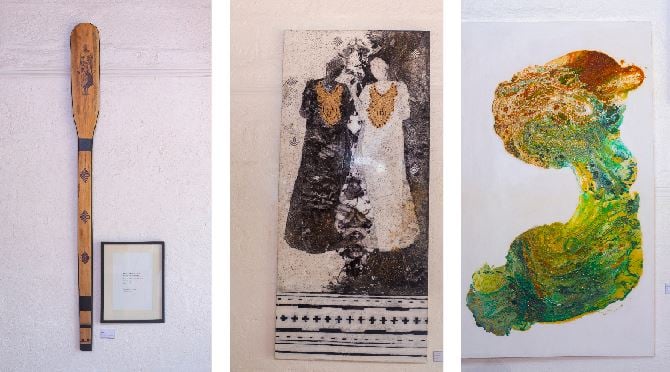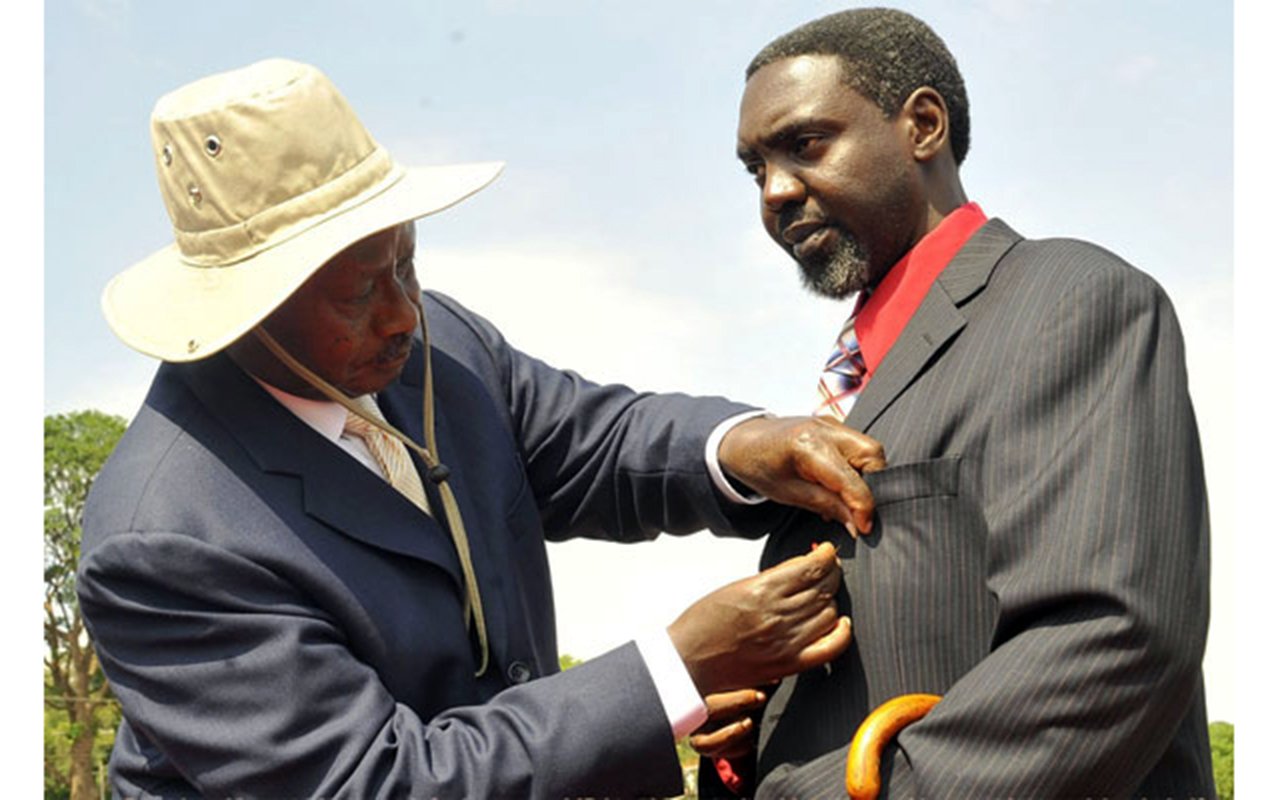Six female artists explore grief in Njabala exhibition

Art pieces: An Elegy - Untitled 2024 by Charity Atukunda, An Elegy - Joy and Sorrow by Charity Atukunda, and An Elegy - Untitled Study 3 - What is that, 2024 by Letaru Dralega. PHOTOS | COURTESY
What you need to know:
- The third edition of the Annual Njabala Exhibition (ANE) titled Njabala: An elegy explores grief through the artistic expressions of various African artists, reflecting personal, communal, and societal experiences of loss and mourning.
The third edition of the Annual Njabala Exhibition (ANE) titled Njabala: An elegy will run its course next Saturday having opened at the Makerere Art Gallery in Kampala on March 5.
The 2024 ANE explores grief through the artistic lens of Liz Kobusinge (Uganda), Lerato Shadi (South Africa/Germany), Helena Uambembe (South Africa), Letaru Dralega (Uganda), Charity Atukunda (Uganda), and Wambui Kamiru Collymore (Kenya).
While for some artists the grief is personal, for the others it is communal or both. Atukunda’s four artworks—Joy and Sorrow, Dreamscape: A Meeting Point, Rituals of Purification, and Handle with Care—typify this. Joy and sorrow, made of charcoal, soil, mica, glue and glaze, depicts two sorrowful women with brown embroideries on their dresses. Atukunda told Saturday Monitor that the image itself is an allegory, a symbol of how the women are intertwined forever.
“I think in the process of grief it’s important to remember that life will bring you both unexpectedly. The brown part of the dress is made of mica, a type of glittery stone that is used in cosmetics,” she said, adding, “I use charcoal and mica throughout the work because they are materials that women use often and they are symbolic of this duality of joy/happiness and sorrow/grief in all the art works.”
Atukunda’s works
Untitled is a pre-made wooden mingling stick with ink and acrylic paint on wood with an image of a woman dressed in the traditional Bakiga leather attire.
“There is a kind of grief I explore within this exhibition that has to do with an aspect of being a woman and the disconnection of not knowing your own culture as a result of colonisation and Christianisation,” Ms Atukunda opined.
She added: “The two to me are inseparable. I learnt more about these two by reading my late father’s thesis on the Christianisation of the Bakiga. The text alongside the mingling stick from his thesis talks about the old tradition of burying women with their mingling stick ‘orwiko’ so they can continue work in their next life.”
The thesis titled Self-Abasement and the Contextualising of Christianity Among the Kiga of Uganda: The Gospel in the Kiga Context for his master’s degree in theology at Princeton University, USA, Stanley Kasse Katungwensi wrote thus: “When a woman was buried, her ladle (orwiko) and hoe handle were buried with her. It was believed that the deceased would also need their tools in the next world where they were believed to live a replica of the life they had lived on earth.”
Dreamscape: A Meeting Point is about the impact of the death of Atukunda’s father on her life. “When I lost my father to Covid-19, I often had dreams about him. Dreams are quite abstract and nothing is clear, but what was clear for me was the feeling of not having lost him,” she revealed.
She added: “I think our minds can sometimes help us to work through grief. Dreams for me became a meeting point of the spirit world and the real world.”
Rituals of Purification is made up of various plants in clay pots. The artist is pointing out the importance of rituals of death among the Bakiga through the use of various pants..
“I also wanted to show the significance these plants held to the minds of the people who used them and performed these rituals,” she said.
Her father addressed the subject in his postgraduate thesis. He wrote about the ritual of purification, okumara orufu (literally meaning getting out of death, followed by the days of mourning). On that day, he wrote, “all the paraphernalia in the house was put outside the house and sprayed with an herbal liquid extracted from omubura, owetango, ebooreera, and mixed with water. The remains of the mixture were poured on the grave. The other herbs were enyaweera, owhihura, and omuhuukye mixed with water and were sprinkled all over the household articles and on the people to remove them from the path of death.”
Handle with Care, Atukunda reveals, “approach[es] the process of grief with a metaphor. The piece is an installation showing a pre-made mortar and pestle with charcoal placed on white cloth flowing to the floor on a table.
“Grief touches and stains everything, just as the charcoal spills over and stains everything that it touches. We must ‘handle ourselves with care’ when it comes to grief and allow ourselves to grieve,” she reasoned.
Wambui finds healing
Wambui has an installation about the processing of grief—All My Venus Days Series 1 (Kampala, 2024). She said this work touches on a very human emotion/state of being and is influenced heavily by the work of Taiwanese-American artist, Tehching Hsieh.
“In the global context with the rising recessions across the world, we are constantly grieving over the political, social and economic situation,” she said, adding, “The work not only ties to the larger populace, but also to the individual experience of grief over loss.”
Wambui has a still image projection—Where Are the Days Going?—in which she captured the changing scene outside her husband’s hospital room, where he was in isolation for more than 30 days. The images show how the world continues to change even though it felt very personally that the world had stopped. The scenes move from October to November 2017.
Art allowed Wambui to remove herself from the overwhelming present, to reflect about the period leading up to and following her husband’s death. It examines love through the practice of domestic labour and arranging/rearranging items as a cathartic practice.
Other works on display
Kobusinge has a video installation on handmade, botanic dyed bark cloth paper in varied dimensions titled, A Garden is a Grave, 2023 – 2024.
“I intend for this work—A Garden is a Grave—to be a meditation on the body as a document of grief within which I construct memory in place of material inheritance,” she said of her paper works that are composed primarily of bark cloth, alpaca wool, and funeral service orders.
She added: “The pulp was imbued with herbs and flowers, evoking funerary rites that centre cleansing and tending the body … The paper is constructed and installed to be reminiscent of my grandmother’s ssuka and blankets as a performance of the grief of inheritance within the context of matrilineal legacies of trauma as told in the story of Njabala.”
Uambembe has an installation with chairs, flowers, burning candles, and hymns titled, In Memory We Love, 2022.
“Beyond my own personal loss, the immediate reference point is the Pomfret community. It is a community that has been through loss caused by war, sickness, carelessness and violence, loss not only of life but also of home, country and self,” Uambembe said of her piece that recreates a wake.
Pomfret is located in South Africa’s Northwest Province, and is home to former Angolan soldiers who, displaced from their own country because of the civil war, were forced to join the apartheid army. According to Uambembe, for the Pomfret community, intimately knowing loss, the community became home and the ritual of funerals became a space to impart knowledge and build identity. The wake, the funeral, and the process of mourning have become an opportunity to gather, and to reconnect.
“In Memory We Love acknowledges that we are in a constant state of mourning; however, it is not just defined by sorrow and pain, but by our choices to continue with hope, joy, song, defiance, the ability to transform and ultimately to love,” Uambembe added.
Lerato has three artworks made of pen and raw linen in her Setswana mother tongue Geta le nna, mo, A nee ntse re ya, and “Gata le nna, gape.
“A lot of my work is also about centring my own experiences. Language becomes a way of also doing that. The works are about a layering of ideas, and experiences. For example, the viewer has no access to the words that have been written,” she told Saturday Monitor.
Dralega said her artworks—Untitled Study 3: What is That?, You Give me Drinking Water (mife mani yi mvuza), and Untitled Study 4: Thank You—are all in some way about grief.
1960s women artists
Besides the art exhibition the Njabala Foundation and Archives of Women Artists, Research and Exhibition (AWARE) organised a symposium held from March 8 to 9 at Makerere University. The symposium focused on the often-overlooked contributions of women artists during this pivotal decade across the African continent. It illuminated the paths and works of women artists whose practice has been blurred for decades and whose contributions to early postcolonial narratives are yet to be recognised.
Guided by a set of key questions, the researchers investigate the identities and stories of women artists from the 1960s, uncover the intricacies of their creative processes, and explore how they navigated the artistic landscape of changing Africa.
The exhibition’s narrative is intertwined with the aftermath of the pandemic. The Njabala Foundation also says the exhibition provides a platform to “collectively process the loss and uncertainty of the chaotic world we inhabit today.” The curatorial notes also disclose that the exhibition “serves as a compassionate exploration of grief’s transformative power and its capacity to strengthen our bonds as a global community.”




